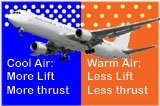Weight-Restricted
As you wait for departure, the gate agent announces that the flight is weight-restricted. What does that mean, is the weight of the aircraft too much? There are many variables that determine whether the aircraft will be weight-restricted, too many to discuss all of them here. However, the three major reasons are described here.
During the winter, high altitude winds in the United States and the Atlantic Ocean increase in intensity from west to east. If you are traveling from west to east, you have high tailwinds pushing you, increasing your groundspeed. Consequently, when traveling from east to west, you have these headwinds pushing against you, slowing you down. Finally, the location of the jet stream is a huge factor in the direction and speed of the winds.
Airline operations, specifically the dispatchers, and the Captain determine how much fuel is needed to get to the destination with these high headwinds. If a high fuel load is needed, this increases the takeoff weight of the aircraft. When figuring the maximum takeoff weight for a particular runway, variables such as runway length, temperature and flap setting must be taken into account. The maximum weight is figured to ensure that for that particular runway, there is sufficient distance to reach takeoff speed, abort the takeoff, and stop in the remaining distance. If the computed weight for your flight exceeds the maximum runway weight limit, either cargo or passengers must be taken off.
The second case for being weight-restricted is typically when it is a hot day at a high airport elevation like Denver or Salt Lake City. The standard rule is the hotter the temperature and higher the airfield is above sea level, the longer the runway is needed. Air density decreases with altitude and heat, so aircraft need longer distances to generate thrust and lift. As in the first case, each runway has its maximum weight limit. As you’ve seen, higher temperature reduces performance and consequently reduces your maximum weight limit. Once again, a decision must be made to offload cargo, passengers, or fuel.

|
| Lift to Wings |
The yellow dots in the above diagram represent air molecules. When air heats up, the molecules spread out and the air becomes less dense. Air flowing around the wings creates lift needed to get a plane into the air. A plane has to go faster to become airborne when it is hot. Less thrust means more runway is needed to gain speed.
The third case involves the calculation of fuel needed over destination when weather forecasts require more fuel then usual (a clear, or partly cloudy day). When weather is marginal at your destination, your flight is required to have an alternate airport just in case the destination weather deteriorate further and your flight cannot land there. Fuel to the alternate and a reserve amount is also added to your fuel requirement. This can put your flight over the maximum landing weight for that particular aircraft. Since the fuel is required and necessary for safety, something has to give. Once again, cargo and passengers may have to be taken off to meet the maximum landing requirements.
As you can see, there are many variables to consider and prioritize. The topmost priority must be safety of flight, followed by timeliness and other objectives. Finally, your airline operations and/or the Captain can decide to do a fuel stop enroute to be sure that removal of passengers and/or cargo is minimized. Of course, an enroute fuel stop will always add extra time for your flight.
Weight-Restricted back to Boarding
Weight-Restricted back to My Airline Flight